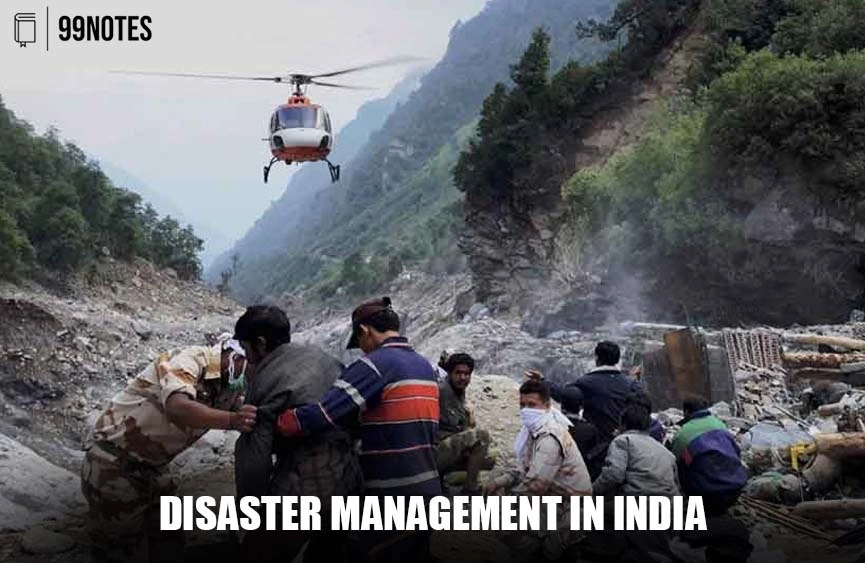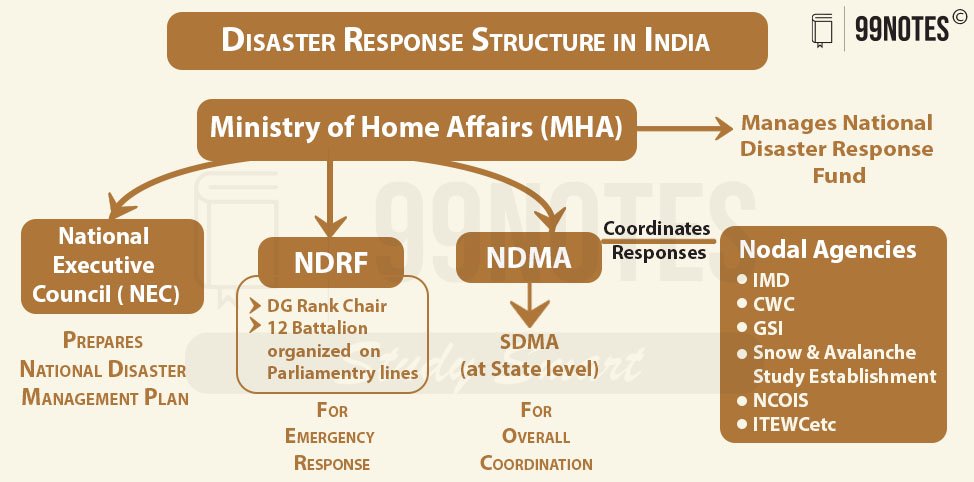Disaster Management in India
When calamities of a severe nature occur, the centre is responsible for providing aid and assistance to the affected state, including deploying armed forces, Central Paramilitary forces or NDRF at the request of the states. Centre’s nodal ministry for coordination for the management of disaster: M/o Home Affairs.
| National Crisis Management Committee (NCMC) |
It has been formed for effective coordination and implementation of relief measures & operations. It gives directions to the Crisis management group.
|
National Disaster Management Act, 2005
The National Disaster Management Act made it a statutory responsibility of the government to protect the citizens against disasters. It put in place several structures to this end.
Definition of a Disaster:
The act defined disaster as a catastrophe, mishap, calamity or grave occurrence affecting any area, arising from natural or man-made causes, or by accident or negligence which results in substantial loss of life or human suffering or damage to, and destruction of, environment and is of such nature or magnitude as to be beyond the coping capacity of the community of the affected area.
National Disaster Management Authority.
It also formed the National Disaster Management Authority as the agency of the Ministry of Home Affairs (MHA), with the Prime Minister as its Ex-Officio chairperson.
Purpose of NDMA
It is designed to be the apex body for disaster management with the following functions:
- Coordinate response to natural or man-made disasters.
- It aims to build a safer and disaster-resilient India by developing a holistic, proactive, multi-disaster and technology-driven disaster management.
- Laying down policy and guidelines.
The NDMA Coordinates response with the help of several Nodal agencies from different ministries.
| Disaster | Agency | Ministry |
| Cyclone | IMD | M/o ES |
| Heat & Cold waves | IMD | M/o ES |
| Tsunami | Indian Tsunami Early Warning Centre (ITEWC), under Indian National Centre for Oceanic Information Services (NCOIS) |
M/o ES |
| Flood | CWC | M/o WR |
| Landslides | Geological Survey of India | M/o Mines |
| Avalanches | Snow & Avalanche study establishment, DRDO | M/o Defence |
| Epidemics | Central Disease Surveillance Unit & State Disease Surveillance Unit | M/o Health and Family Welfare |
National Executive Council:
The National Executive Committee (NEC) of NDMA makes decisions on the expenses of the National Disaster Response Fund (NDRF). Members of the NEC comprise secretaries of the concerned central government ministries and departments.
- It assists NDMA in discharging its duties and functions and ensures compliance with the directions issued by the Government of India.
- It also prepares the National Disaster Management Plan.
State Executive Committees (SECs) perform similar functions at the state level.
National Disaster Management Plan (NDMP) – 2016
The NDMP-2016 is the first ever national plan(previously only policies were prepared) prepared in the country for disaster management. To align our National Plan with the Sendai Framework for DRR.
- It is based on 4 priority themes of the Sendai Framework, i.e.:
- Understanding disaster risk,
- Improving disaster risk governance,
- Investing in disaster reduction (through structural and non-structural measures) and disaster preparedness,
- Early warning and building back better in the aftermath of a disaster. It provides for horizontal and vertical integration among all the agencies and departments of the government up to the local level.
- A regional approach has been adopted for better disaster management as well as planning.
The earlier NDMP-2009 too was based on 4 priority themes of the Sendai Framework.
National Disaster Response Force (NDRF):
The National Disaster Response Force is India’s elite disaster mitigation combat force established under DM Act, 2005. It is a specialised force constituted for specialist response to a threatening disaster situation or disaster. It functions under the Ministry of Home Affairs, as per the directions of the NDMA.
Structure of NDRF
It is headed by a senior IPS officer appointed as Director General (DG) of NDRF.
It has 12 battalions(of approx. 1150 personnel each), organized on para-military lines, and manned by persons on deputation from the para-military forces:3 from BSF, 3 from CRPF, 2 from CISF, 2 ITBP, 2 from Sashashtra Seema Bal.
Functions of NDRF:
It is mandated to undertake special disaster response, relief, rescue operations and combat roles independently in the case of an event of any disaster (natural or man-made), accident or emergency.
It also assists local authorities in launching a quick rescue and response operation to save lives, property and infrastructure.
Problems with NDRF:
NDRF has several major problems, making it less effective in responding to disasters.
- No specialised recruitment – It takes personnel with combat experience from the paramilitary forces of India.
- Further, it is a Top-heavy organization, i.e. it lacks manpower at the lower level.
- National and State Disaster Response Fund.: next page.
State Disaster Management Authority:
The Disaster Management Act, 2005 envisions that every state government would create its own State Disaster Management Authority.
National Disaster Response Fund
The National Disaster Response Fund (NDRF) is a statutory fund, set up under section 46 of the Disaster Management Act, 2005. It is managed by the Central government for meeting the expenses for emergency response, relief and rehabilitation.
The objective of the fund:
It is constituted to supplement State Disaster Response Funds (SDRF), set up under the DM Act.
- The Central Government enhanced its Contribution to SDRF from 75% to 90%. w.e.f. 1st April 2018.
- SDRF is the main fund through which immediate response is funded.
- Disaster (s) covered under SDRF: Cyclone, drought, earthquake, fire, flood, tsunami, hailstorm, landslide, avalanche, cloudburst, pest attack, frost and cold waves.
It is only for post-disaster issues, related to immediate relief (but not compensation) Disaster preparedness, restoration, reconstruction and mitigation are not a part of SDRF. For this, there is a Mitigation fund.
Structure of the Fund
It is located in the Public Account of India and is managed by the Ministry of Home Affairs.
- It is financed through the levy of cess on certain items, chargeable to excise and customs duty.
- It is approved annually through a finance bill.
- The requirement for funds beyond what is available through NDRF is met through general budgetary resources.
The Central Government enhanced its Contribution to the State Disaster Response Fund (SDRF) from 75% to 90%. w.e.f. 1st April 2018.
Concerns
The Sendai Framework and the new National DM Plan demand a focus on disaster prevention, preparation and mitigation. Before 2021, we had a fund only for disaster response, the proceeds from which could not be used for other purposes. Further, the government often used the response fund to distribute compensation.
- Reason for not forming the mitigation fund: According to the Government, the existing mechanisms through other central schemes such as PMKSY, Krishonnati Yojana, National Mission on Sustainable Agriculture, MGNREGA, and Nmami Gange worked in the direction of Mitigation of hazards. Mitigation funds would lead to duplication of efforts.
- Concern: In May 2016, SC asked the government to constitute a separate fund for the mitigation of disasters, and the Response fund to be used only for emergencies during the disaster response.
- A contempt plea was further filed against PM Narendra Modi, Union Home Minister Amit Shah and Finance Minister Nirmala Sitharaman for not formulating the National Disaster Mitigation Fund (NDMF) as directed by the top court in 2016. It was thus formed in 2021.
| National Disaster Mitigation Fund (NDMF) |
| The NDMF was formed by the central government in 2021. It is a non-statutory fund, i.e. not formed under the National Disaster Management Act. It is formed under the provisions of the National Disaster Management Plan, 2016. |
| Relief Fund |
| Several departments manage their own relief funds for the compensation of the people affected by the disasters. For example, the Department of Agriculture and Cooperation (Agriculture Ministry) monitors relief activities for calamities associated with drought, hailstorms, pest attacks and cold waves/frosts while the rest of the natural calamities are monitored by MHA. |
Government steps to manage Overall Risks:
The above-mentioned steps are required to be performed by the government under the provisions of the Disaster Management Act. The government has taken several steps beyond the mandate of the Act.
National Disaster Management Centre (NDMC)
The structure that we have mentioned above mainly deals with the response. For overall planning coordination and Policy formulation, NDMC is created.
The National Disaster Management Centre (NDMC) is an institution focused on disaster preparedness, response, and capacity building. It supports policy formulation, training, and research in disaster management. NDMC collaborates with agencies like NDMA, NIDM, and SDRFs to enhance India’s resilience against disasters, ensuring effective coordination and risk reduction strategies.
It was formed in 2004 in the Aftermath of the Indian Ocean Tsunami since it was felt that we cannot only respond to disasters passively and more efforts are required to reduce the risk of disasters.
Mitigation and Risk Management Funds
The government has decided to set up such a fund to implement a May 2016 Supreme Court Judgement as a part of the National Disaster Management Plan, 2016. The 15th Finance Commission has recommended a National Disaster Risk Management Fund (NDRMF) and SDRMF in this regard.
National Disaster Risk
National Disaster Risk Index has been developed by the MHA and UNDP: It maps hazards & vulnerabilities including economic vulnerabilities across 640 districts and all states including UTs. The index factors in the exposure of population, agriculture & livestock and environmental risk. It will be used to prepare a composite disaster scorecard (DSC).
The index is in line with India’s commitment to the Sendai Framework.
Several facts are brought forth through this index in recent times:
- High-Risk districts: North 24 Parganas, Pune and South 24 Parganas
- High-Risk States: Maharashtra, West Bengal and Uttar Pradesh.
- Urban Development Programs: Smart Cities Mission, AMRUT and Heritage City Development and Augmentation Yojana(HRIDAY). SDG – 11 Sustainable cities.
Initiatives for the Urban Areas
The Ministry of Housing and Urban Affairs has launched two initiatives:
- Angikaar, a campaign for behavioural change and an e-Course on ‘Vulnerability Atlas of India’.
- E-course on Vulnerability Atlas-It is a unique course that offers awareness and understanding about natural hazards, helps identify regions with high vulnerability with respect to various hazards and specifies the district-wise level of damage risks to the existing housing stock. The e-course will be a tool for effective & efficient disaster mitigation & management in the fields of Architecture, Civil Engineering, Urban & Regional Planning, Housing & Infrastructure Planning, Construction Engineering & Management and Building & Materials Research.
‘National Migrant Information System (NMIS)’:
It is developed by NDMA. It is an online dashboard, which would maintain a central repository of migrant workers and help in speedy inter-state communication to facilitate the smooth movement of migrant workers to their native places.
Coalition for Disaster Resilient Infrastructure (CDRI):
It was announced in the 2020 Budget, proposed by PM, that it will act as a convening body that will pool best practices and resources from around the world for reshaping construction, transportation, energy, telecommunication and water, so that building in these core infrastructure sectors factors in natural catastrophes.
- CDRI could fill the Infrastructure gap in funds and technology and help developing countries build disaster-resilient Infrastructure.
- Launched by India at the Global Climate Action Summit in New York in 2019.
Apart from these, several other steps are taken by the government which can reduce the disaster risks. For example:
- Satellite support through IRNSS and Gagan
- First Resilient Kerala Program: Launched by the Government of India, the Government of Kerala. The World Bank has signed a Loan Agreement of USD 250 million. It aims to enhance the State’s resilience against the impacts of natural disasters and climate change.







